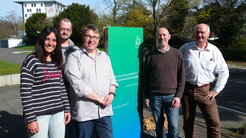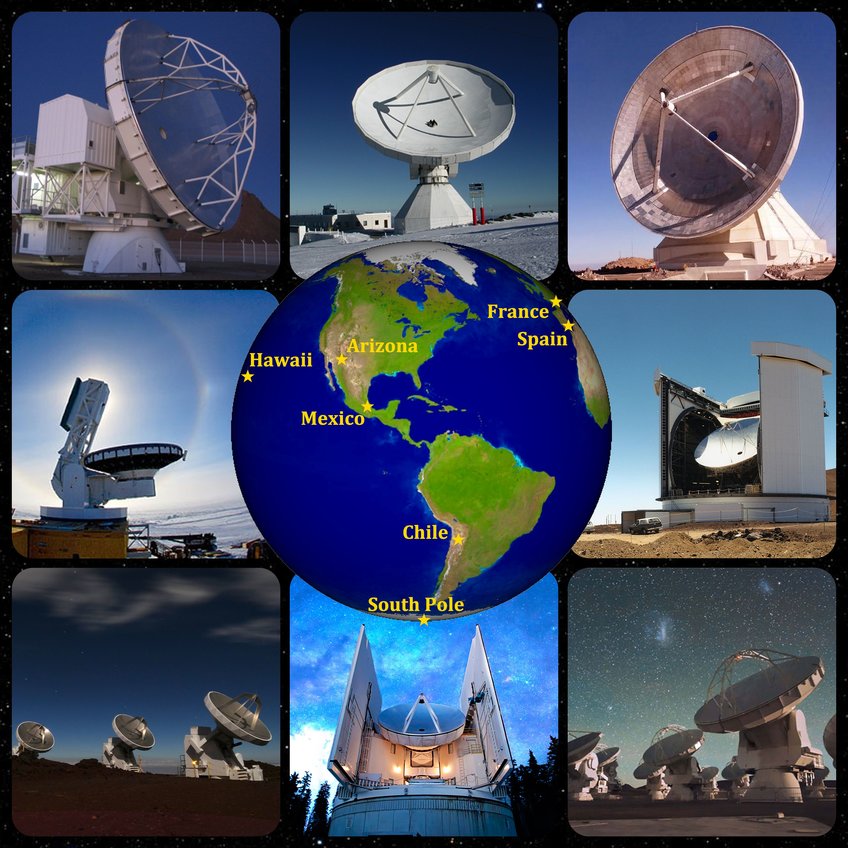Event Horizon Telescope
Observations in a world-wide radio telescope network in April 2017
The „Event Horizon Telescope”(EHT) is a project in international collaboration with the goal to directly image the immediate environment of a black hole. This will allow to test Einstein’s Theory of General Relativity in an extreme regime. A number of European research institutes including the Max Planck Institute for Radio Astronomy in Bonn/Germany participate in the observations within the framework of an international consortium.

The EHT consortium consists of 14 institutes with about 200 participants in Europe, Asia, Africa and America. Chair of the EHT interim board is Prof. J. Anton Zensus from the Max Planck Institute for Radio Astronomy (MPIfR), Director of the EHT is Dr. Shepherd S. Doeleman (Harvard & MIT, USA).
The research department of Prof. Michael Kramer at MPIfR is participating via the „BlackHoleCam“ (BHC) project, founded by the European Research Council (ERC), in collaboration with Prof. Heino Falcke (Radboud University Nijmegen, The Netherlands) and Prof. Luciano Rezzolla (Frankfurt University, Germany).
The technique applied for the EHT observations is called Very Long Baseline Interferometry (VLBI). VLBI enables the highest resolutions in astronomy by coupling a number of radio telecopes distributed across different countries on Earth. This method is used for the investigation of the direct environment of supermassive black holes in active galactic nuclei, in particular jets of high-energy particles emitted from the central regions. In the framework of the EHT project it will become possible to directly image the central black holes in addition to the jets. This is achieved by observations at shorter radio waves of only 1.3 mm wavelength. The resolution of the world-wide network of radio telescopes at that wavelength corresponds to a magnification factor of two million or the size of a tennis ball in the distance of the moon.
To minimize the impact of the Earth’s atmosphere at that wavelength, the observations are only possible at high-altitude dry sites like the Atacama desert in Chile, the Sierra Nevada in southern Spain, high volcanoes at Hawaii or even the South Pole.
Including the Atacama Large Millimeter Arrays (ALMA) with its 64 dishes in total provides a very high sensitivity. In total it is synthesizing a radio telescope with an equivalent diameter of 84 meters, superior to the usual Millimeter-wave radio telescopes with 15 to 30 meters in diameter. After a preparation phase of several years observations within the EHT project will now take place between April 04 and April 14 this year (see below).
VLBI data sets are analyzed in dedicated super computers, the so-called correlators. For the analysis of the EHT observations two correlators will be used, at the Max Planck Institute for Radio Astronomy in Bonn (Head of the Correlator group: Walter Alef) and at Haystack Observatory in Haystack, Massachusetts, USA.
For an overall picture of the physics of black holes the observations are complemented by numerical simulations and tests with synthetical data.
The obervations are co-financed by the European ERC project BlackHoleCam (BHC) and supported among others by Max Planck Society.
As a part of the BHC project, MPIfR scientists are searching for pulsars in the direct neighbourhood of the black hole in the centre of the Milky Way in order to establish independent measurements of its properties.
--------------------
Before the start of the EHT observations, the Global Millimetre-VLBI Array (GMVA) network will perform observations at 3 mm wavelength with 14 antennas from March 31 to April 04, focusing on several active galaxies. Three of those targets will be observed jointly with the ALMA telescope in Chile. The 100-m radio telescope in Effelsberg will participate in the GMVA observations. The analysis of the GMVA observations including phased ALMA will be completely postprocessed at the MPIfR correlator in Bonn.
ros/njn

Telescope Network (Observations: April 04 to 14, 2017):
▪ Atacama Pathfinder Experiment (APEX) in Chile, supervised by MPIfR
VLBI observations: Alan Roy, Jan Wagner, Sven Dornbusch
▪ Atacama Large Millimeter Array (ALMA) in Chile, supervised by an international collaboration (including European Southern Observatory, ESO)
VLBI observations from MPIfR: Helge Rottmann
▪ 30-m Telescope at Pico Veleta, Spain, supervised by German-French-Spanish IRAM institute
VLBI observations from MPIfR: Thomas P. Krichbaum, Helge Rottmann, Rebecca Azulay; from IRAM among others: Pablo Torne
▪ South Pole Telescope (SPT), supervised by an international collaboration (among others: Ludwig Maximilian University, Munich)
▪ James Clark Maxwell Telescope (JCMT) on Mauna Kea, Hawaii, USA, supervised by East Asian Observatory (Taiwan, China, Japan and South Korea)
▪ Large Millimeter Telescope (LMT) Alfonso Serrano, supervised by Instituto Nacional de Óptica y Electrónica, Mexico and University of Massachussetts, USA
▪ Submillimeter Array (SMA) on Mauna Kea, Hawaii, USA
▪ Submillimeter Telescope (SMT) in Arizona, USA
Additional telescopes will complement EHT observations in the future: NOEMA (Plateau de Bure, France), Greenland Telescope, Africa Millimeter Telescope (planned).

List of Sources:
The EHT observations in April 2017 will comprise a total of six sources:
▪ The Galactic Centre, Sagittarius A*, in a distance of 25,000 light years in the constellation „Sagittarius“ (EHT project)
▪ Active galaxy Virgo A (Messier 87 or M 87), in a distance of 53 million light years in the constellation „Virgo“ (EHT project). Results from these observations revealed the first image ever of a black hole (MPIfR PR 2019/4, April 10, 2019), For this result the EHT collaboration was awarded, among others, with the Breakthrough Prize for Fundamental Physics (MPIfR PR 2019/8, September 5, 2019), and later the detection of polarized light at the edge of the black hole (see MPIfR PR 2021/3, March 24, 2021).
▪ Southern Galaxy Centaurus A, in a distance of 13 million light years in the constellation “Centaurus” (PI project: Cornelia Müller - c.mueller@astro.ru.nl. The leadership of the project was taken by Michael Janßen - mjanssen@mpifr.de)
▪ Quasar OJ 287, in a distance of 3.5 billion light years in the constellation “Cancer“ (PI project: José Luis Gómez - jlgomez@iaa.es)
▪ Elliptical galaxy NGC 1052, in a distance of 63 million light years in the constellation “Cetus” (PI project: Matthias Kadler - kadler@physik.uni-wuerzburg.de & Eduardo Ros - ros@mpifr.de)
▪ Quasar 3C 279, in a distance of 5 billion light years in the constellation „Virgo“ (PI project: Thomas Krichbaum - tkrichbaum@mpifr.de. The completion of the work was led by J.Y. Kim - jykim@mpifr.de, resulting in unprecedently sharp images in the innermost region of this blazar (MPIfR PR 2020/4, April 07, 2020)
▪ Active Galaxy 3C 84 (Perseus A), the central galaxy of the Perseus galaxy cluster at a distance of 240 million light years
▪ Further active galaxies (like 3C 273) will be used as calibration sources.
Sgr A* in the centre of our Milky Way and the central source of galaxy M87 in the Virgo galaxy cluster represent the two key sources for the EHT project.
.
EHT: Partner institutions and their contact persons:
- Max Planck Institute for Radio Astronomy
o Prof. Dr. J. Anton Zensus (Chair of EHT Board) – azensus@mpifr.de
o Prof. Dr. Michael Kramer (BHC Main Investigator) – mkramer@mpifr.de
o Prof. Dr. Karl Menten (APEX) - kmenten@mpifr.de
o Dr. Thomas P. Krichbaum (Scientist) – tkrichbaum@mpifr.de
o Prof. Dr. Eduardo Ros (EHT Secretary) – ros@mpifr.de
o Dr. Walter Alef (Head of Correlator Group at MPIfR Bonn) – walef@mpifr.de
o Dr. Alan Roy (Supervisor of APEX EHT observations) – aroy@mpifr.de
o Dr. Helge Rottmann (Supervisor of Pico Veleta and ALMA EHT observations) – hrottmann@mpifr.de
- Goethe University, Frankfurt, Germany
o Prof. Dr. Luciano Rezzolla (BHC Main Investigator) - rezzolla@th.physik.uni-frankfurt.de
- Radboud Universiteit Nijmegen, Niederlande
o Prof. Dr. Heino Falcke (BHC Main Investigator) - H.Falcke@astro.ru.nl
o Dr. Remo Tilanus (EHT Project Manager) - rtilanus@strw.leidenuniv.nl
- Institut de radioastronomie millimétrique (IRAM), Grenoble, France, and Granada, Spain
o Dr. Karl Schuster - schuster@iram.fr
- Haystack Observatory, Massachusetts Institute of Technology, MA, USA
- Smithsonian Astrophysical Observatory, Harvard University, MA, USA
o Dr. Shepherd S. Doeleman (EHT-Director) - sdoeleman@cfa.harvard.edu
o Prof. Dr. Dimitrios Psaltis (EHT-Project Scientist) - dpsaltis@email.arizona.edu
- Perimeter Institute, Waterloo, ON, Canada
- Large Millimeter Telescope, Mexiko
- University of Chicago, IL, USA
- University of Arizona, Tucson, AZ, USA
- Academia Sinica Institute of Astronomy and Astrophysics, Taipei, Taiwan
- National Astronomical Observatory of Japan, Tokyo, Japan


